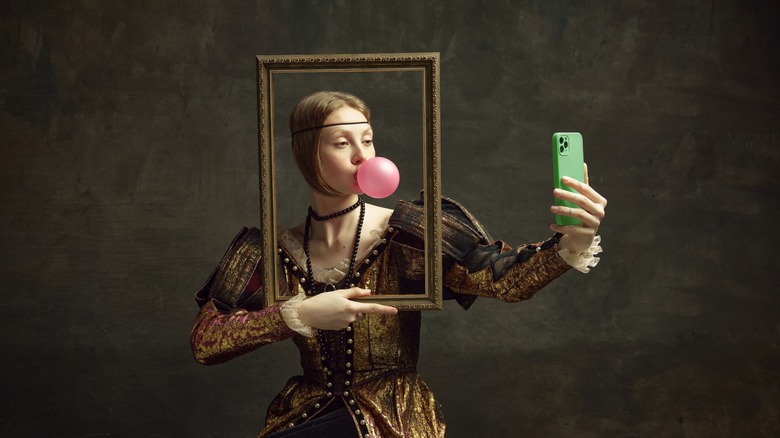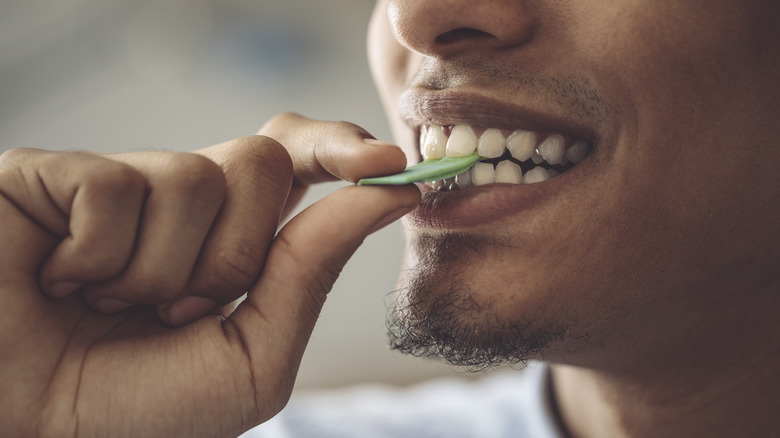The Origin Of Chewing Gum May Not Be What You Expect
Have you ever looked at a tree swaying in the wind and thought, "I bet I could chew on that?" Well, many thousands of years ago, Mesoamerican people had that thought and today we owe them for the substance we call chewing gum. Popping bubbles of sweet pink bubblegum may seem like a modern tableau, but people have been looking for things to passively chew on for millenniums (although their version of chewing gum did look much different from the ones we recognize nowadays).
The ancient Mayan and Aztec people are believed to be the first groups to discover chewable resin from the bark of sapodilla trees, which are native to Mexico and Central America. This sticky substance, referred to as chicle, was used to curb appetites and promote dental health. Author and historian Jennifer P. Mathews reported in her book, "Chicle: The Chewing Gum of the Americas," that ancient Mayans did not allow just anyone to chew on chicle while out and about. Only unwed women and children could enjoy the gum-like substance in public. Mature, married women and men had to keep their chewing habits a secret.
Obviously, chewing gum has come a long way since its tree bark roots, arriving on shelves in strips wrapped in foil, smelling of sweet fruits and even desserts. It wasn't until the 1800s that American inventors got their hands on this natural latex and began experimenting with ways to make it taste good, introducing the United States to long-lasting chewing gum.
Chewing gum was a big hit in the United States
Chicle made its way to the United States thanks to exiled Mexican president Antonio López de Santa Anna, who brought the substance to New York inventor Thomas Adams in hopes of making a profit off of an innovative rubber alternative. According to The Smithsonian Magazine, historians continue to be puzzled about exactly how the two men found each other, although gum chewers are especially glad they did. In 1880, after many failed attempts, Adams discovered the substance was best used as a long-lasting chewing gum.
Per History, Adams was not the first to sell chewing gum to the public, but he was by far the most successful. His competitors' products struggled to maintain an appealing flavor and keep its sticky consistency while chewing. In the decades after Adams' chewy discovery, big names like William Wrigley Jr. and Frank Fleer saw people's desire for something flavorful to keep their mouths busy. Utilizing the newly imported chicle, they began working on their own formulas for chewing gum. Wrigley originally gave out his gum for free to customers who bought soaps from his soap business, until fans expressed more interest in the deliciously minty sticks of gum than his actual products. The initial audience of gum in the U.S. was children who enjoyed the sticky substance and sweet flavors like vanilla, mint, and fruit flavoring. Soon, companies began to target adults, promising that gum would prevent cavities and cure their bad breath.
Chewing gum has drastically improved in taste and texture
Whether you're chewing it after a particularly pungent meal or attempting to blow a bubble bigger than your face, the chewing gum you know and love has come a long way since it first arrived on shelves. Before the discovery of chicle, gum manufactured in America was mainly made with spruce resin, a type of waxy substance that did not last very long or taste very good. While the inventor, John Curtis, found some success selling this version of chewing gum, the sticky substance evolved into a much tastier, elastic substance that could be enjoyed for longer periods of time once chewing gum titans like William Wrigley Jr. and Frank Fleer entered the chat. Chewing gum brands like Double Bubble, Wrigley's, and Juicy Fruit have been around since the 1800s, although the modern ingredient list looks drastically different.
While the substance did provide gum with its recognizable elasticity for decades, most of the gum available today no longer utilizes chicle in favor of synthetic gum materials. According to BBC Science Focus, most chewing gums on shelves today are made out of polyisobutylene, a man-made material that mostly consists of plastic particles. Various emulsifiers and other was-like substances are added to give gum that signature stretchiness perfect for blowing bubbles, and flavored with artificial extracts. Because of the high amount of long-lasting synthetic materials, most chewing gum doesn't actually need an expiration date.


